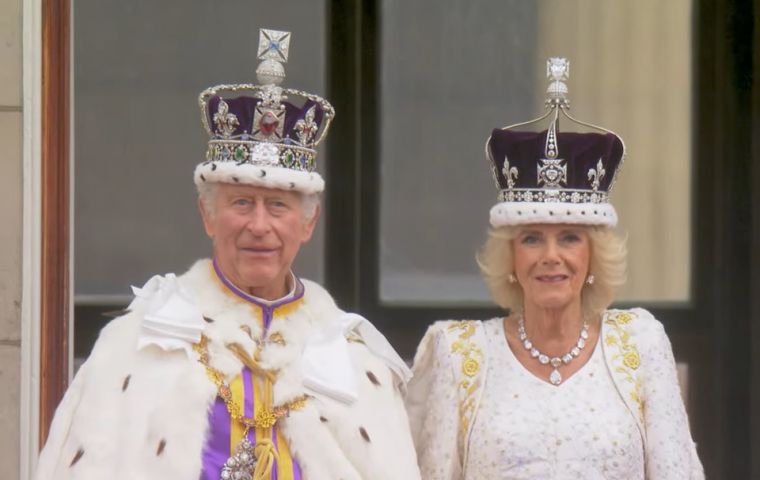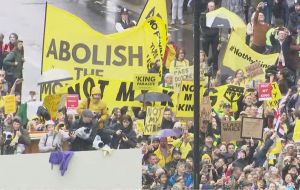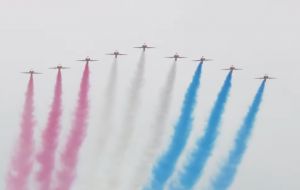MercoPress. South Atlantic News Agency
King Charles III and Queen Camilla crowned in moving ceremony
 Thousands camped for days outside Buckingham Palace for a chance to greet King Charles III and Camilla when they appeared on the balcony
Thousands camped for days outside Buckingham Palace for a chance to greet King Charles III and Camilla when they appeared on the balcony  The royal carriage passed by yellow banners reading “Not My King.”
The royal carriage passed by yellow banners reading “Not My King.”  The Red Arrows performed a limited RAF show due to poor weather
The Red Arrows performed a limited RAF show due to poor weather Charles III and his wife Camilla were crowned King and Queen Saturday at Westminster Abbey, during a historic ceremony not seen since 1953 when the late Elizabeth II accessed the throne. Most people camped joyfully for days outside Buckingham Palace waiting for the opportunity to greet the sovereign despite the rainy weather. But there were also some unruly demonstrations against the monarchy, which led to some arrests, it was reported from London.
Inside Westminster Abbey, some 2,300 guests watched the ceremony, including U.S. First Lady Jill Biden, Brazilian President Luiz Inácio Lula da Silva and King Felipe VI and Queen Letizia of Spain, as well as hundreds of representatives of British civil society.
Before their eyes, and those of millions of television viewers, Charles III, 74, and Camilla, 75, solemnly entered, dressed in ceremonial cloaks, to be consecrated at the top of the British monarchy, eight months after ascending the throne following the death of Elizabeth II, who reigned for seven decades.
Although the king wanted a more modern and simpler ceremony than that of his mother, in a context of serious crisis due to the high cost of living, the ceremony is carried out according to a pompous ritual that has remained practically unchanged for centuries.
Despite the crisis, the monarchs used three crowns set with diamonds and precious stones, several ancient robes embroidered with gold that the king wore at different stages of the ceremony, three scepters, and a pair of gold spurs. In a nod to modern concerns, the oil used in the anointing was vegan, though consecrated as tradition demands in the Church of the Holy Sepulcher in Jerusalem.
In what is considered the most sacred part of the ceremony, the Archbishop of Canterbury, spiritual leader of the Church of England, of which the king is the supreme head, anointed the hands, chest, and head of Charles III and Camilla, hidden from view by a screen.
The centerpiece of the ceremony came when Archbishop Justin Welby placed on his head the spectacular crown of St. Edward, which is only worn at the moment of coronation.
Replacing the traditional aristocrats' pledge, Archbishop Welby invited everyone, from wherever they were watching or listening, to swear allegiance to the new king, a historic first that sought to democratize the ceremony, but which provoked strong criticism.
Outside the Abbey, thousands of Britons and tourists gathered to watch the ceremony, many carrying flags or dressed in costumes with their colors. Some opted for a spot on the street where they could watch some of the ceremony while others gathered at designated locations to watch the broadcast on screen, such as in Hyde Park.
On their way from Buckingham Palace to the temple and back, the royal couple passed by yellow banners from the anti-monarchy group Republic, which read “Not My King.” A group of these activists was arrested as they prepared to protest. About 20 members of the environmental group “Just Stop Oil” were also taken into custody.
Few Latin American representatives were present at the celebration. In addition to President Lula, Paraguay's Mario Abdo Benítez was the only head of state present, joined by Salvadorean Vice President Félix Ulloa and Colombian First Lady Verónica Alcocer. Venezuela was not invited to the coronation as other countries such as Afghanistan, Belarus, Iran, Myanmar, Russia, and Syria.




Top Comments
Disclaimer & comment rules-

Read all commentsEat your heart out, CFK.
May 06th, 2023 - 11:32 pm +1Commenting for this story is now closed.
If you have a Facebook account, become a fan and comment on our Facebook Page!